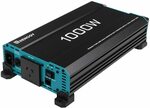The perfect addition to any off-grid system, whether for a van or a cabin, the Renogy 1000W Pure Sine Wave Power Inverter acts as a DC to AC converter that allows you to power your household appliances. Unlike modified sine wave inverters, this 1000W inverter is a pure sine wave, capable of producing cleaner, smoother, and more reliable electricity to operate tools, fans, lights, and other electronics without interference. Many off-grid systems require a 12V solar inverter to power everyday electronics and this one includes multiple protections to help things run smoothly and safely.
The AC priority switch function enables the inverter automatically switch from the battery (DC) to the mains (AC) and vice versa whenever the utility company takes/loses power!
Safe
Electronic overload protection with automatic shutdown.
Built-in internal backup DC fuse provides added safety.
Low battery voltage protection with automatic shutdown.
Over temperature protection with automatic shutdown.
Output short circuit protection.
UPS (AC priority switch) function: Transfers input power between battery supply & AC main within 50mS
RENOGY 1000W 12V PURE SINE WAVE INVERTER
Input Voltage: 12VDC Continuous Power: 1000W
Surge Power: 2000W Output Voltage: 220VAC±10
Output Frequency (Nominal): 50Hz±0.3 Output Wave form:Pure Sine Wave
No Load Current Draw: < 1A Input Voltage Range: 11-16Vdc
Low Voltage Shutdown: 10Vdc Recover from low voltage protection
Battery supply & AC main transfer time within 50ms Efficiency: > 90%
Dimensions: 34.2 x 17.3 x 7.6 cm Weight: 2.6Kg
Certifications:
CE YES
EMC YES



 CamelCamelCamel
CamelCamelCamel

Cheaper by 10% on the eBay store with the BD10OFF code: https://www.ebay.com.au/itm/293399740739